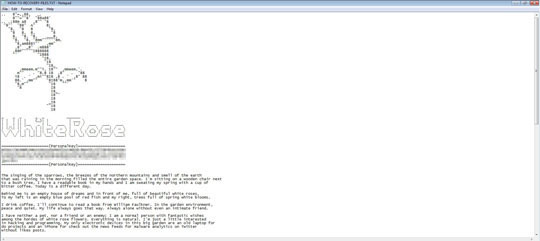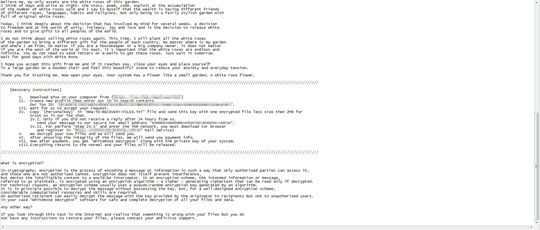RANSOM_WHITEROSE.THDOBAH
Trojan-Ransom.Win32.Gen.hql (Kaspersky) ; Mal/Infitear-A (Sophos-Lite) ; Ransom:Win32/Genasom (Microsoft)
Windows


Threat Type: Ransomware
Destructiveness: No
Encrypted: Yes
In the wild: Yes
OVERVIEW
Downloaded from the Internet, Dropped by other malware
This Ransomware arrives on a system as a file dropped by other malware or as a file downloaded unknowingly by users when visiting malicious sites.
It encrypts files with specific file extensions. It drops files as ransom note.
TECHNICAL DETAILS
27,648 bytes
EXE
No
26 Mar 2018
Drops files, Encrypts files, Displays message/message boxes
Arrival Details
This Ransomware arrives on a system as a file dropped by other malware or as a file downloaded unknowingly by users when visiting malicious sites.
Installation
This Ransomware drops the following files:
- %System Root%\Perfect.sys -> Use to check if the machine is already infected
(Note: %System Root% is the Windows root folder, where it usually is C:\ on all Windows operating system versions.)
Other Details
This Ransomware does the following:
- It deletes shadow copies by executing the following command:
- cmd.exe /C vssadmin.exe delete shadows /all /Quiet
- cmd.exe /C WMIC.exe shadowcopy delete
- cmd.exe /C Bcdedit.exe /set {default} recoveryenabled no
- cmd.exe /C Bcdedit.exe /set {default} bootstatuspolicy ignoreallfailures
- cmd.exe /C wevtutil.exe cl Application
- cmd.exe /C wevtutil.exe cl Security
- cmd.exe /C wevtutil.exe cl System
Ransomware Routine
This Ransomware encrypts files with the following extensions:
- .gif
- .apk
- .groups
- .hdd
- .hpp
- .log
- .m2ts
- .m4p
- .mkv
- .mpeg
- .epub
- .yuv
- .ndf
- .nvram
- .ogg
- .ost
- .pab
- .pdb
- .pif
- .png
- .qed
- .qcow
- .otp
- .s3db
- .qcow2
- .rvt
- .st7
- .stm
- .vbox
- .vdi
- .vhd
- .vhdx
- .vmdk
- .vmsd
- .psafe3
- .vmx
- .vmxf
- .3fr
- .3pr
- .ab4
- .accde
- .accdr
- .accdt
- .ach
- .acr
- .sd0
- .sxw
- .adb
- .advertisements
- .agdl
- .ait
- .apj
- .asm
- .awg
- .back
- .backup
- .sti
- .oil
- .backupdb
- .bay
- .bdb
- .bgt
- .bik
- .bpw
- .cdr3
- .cdr4
- .cdr5
- .cdr6
- .ycbcra
- .cdrw
- .ce1
- .ce2
- .cib
- .craw
- .crw
- .csh
- .csl
- .db_journal
- .dc2
- .pptm
- .dcs
- .ddoc
- .ddrw
- .der
- .des
- .dgc
- .djvu
- .dng
- .drf
- .dxg
- .eml
- .ppt
- .erbsql
- .erf
- .exf
- .ffd
- .fh
- .fhd
- .gray
- .grey
- .gry
- .hbk
- .ibd
- .7z
- .ibz
- .iiq
- .incpas
- .jpe
- .kc2
- .kdbx
- .kdc
- .kpdx
- .lua
- .mdc
- .mef
- .config
- .mfw
- .mmw
- .mny
- .mrw
- .myd
- .ndd
- .nef
- .nk2
- .nop
- .nrw
- .ns2
- .ns3
- .ldf
- .ns4
- .nwb
- .nx2
- .nxl
- .nyf
- .odb
- .odf
- .odg
- .odm
- .orf
- .otg
- .oth
- .py
- .ots
- .ott
- .p12
- .p7b
- .p7c
- .pdd
- .pem
- .plus_muhd
- .plc
- .pot
- .pptx
- .py
- .qba
- .qbr
- .qbw
- .qbx
- .qby
- .raf
- .rat
- .raw
- .rdb
- .rwl
- .rwz
- .conf
- .sda
- .sdf
- .sqlite
- .sqlite3
- .sqlitedb
- .sr2
- .srf
- .srw
- .st5
- .st8
- .std
- .stx
- .sxd
- .sxg
- .sxi
- .sxm
- .tex
- .wallet
- .wb2
- .wpd
- .x11
- .x3f
- .xis
- .ARC
- .contact
- .dbx
- .doc
- .docx
- .jnt
- .jpg
- .msg
- .oab
- .ods
- .pps
- .ppsm
- .prf
- .pst
- .rar
- .rtf
- .txt
- .wab
- .xls
- .xlsx
- .xml
- .zip
- .1cd
- .3ds
- .3g2
- .7zip
- .accdb
- .aoi
- .asf
- .asp
- .aspx
- .asx
- .avi
- .bak
- .cer
- .cfg
- .class
- .cs
- .css
- .csv
- .db
- .dds
- .dwg
- .dxf
- .flf
- .flv
- .html
- .idx
- .js
- .key
- .kwm
- .laccdb
- .lit
- .m3u
- .mbx
- .md
- .mdf
- .mid
- .mlb
- .mov
- .mp3
- .mp4
- .mpg
- .obj
- .odt
- .pages
- .php
- .psd
- .pwm
- .rm
- .safe
- .sav
- .save
- .sql
- .srt
- .swf
- .thm
- .vob
- .wav
- .wma
- .wmv
- .xlsb
- 3dm
- .aac
- .ai
- .arw
- .c
- .cdr
- .cls
- .cpi
- .cpp
- .cs
- .db3
- .docm
- .dot
- .dotm
- .dotx
- .drw
- .dxb
- .eps
- .fla
- .flac
- .fxg
- .java
- .m
- .m4v
- .max
- .mdb
- .pcd
- .pct
- .pl
- .potm
- .potx
- .ppam
- .ppsm
- .ppsx
- .pptm
- .ps
- .r3d
- .rw2
- .sldm
- .sldx
- .svg
- .tga
- .wps
- .xla
- .xlam
- .xlm
- .xlr
- .xlsm
- .xlt
- .xltm
- .xltx
- .xlw
- .act
- .adp
- .al
- .1
- .bkp
- .blend
- .cdf
- .cdx
- .cgm
- .cr2
- .crt
- .dac
- .dbf
- .dcr
- .ddd
- .design
- .dtd
- .fdb
- .fff
- .fpx
- .h
- .iif
- .indd
- .jpeg
- .mos
- .nd
- .nsd
- .nsf
- .nsg
- .nsh
- .odc
- .odp
- .pas
- .pat
- .pef
- .pfx
- .ptx
- .qbb
- .qbm
- .sas7bdat
- .say
- .st4
- .st6
- .stc
- .sxc
- .tlg
- .wad
- .xlk
- .aiff
- .bmp
- .cmt
- .dat
- .dit
- .edb
- .flvv
- .avhd
- .back
- .c
- .ctl
- .dbf
- .disk
- .dwg
- .gz
- .nrg
- .ora
- .ova
- .ovf
- .pmf
- .ppt
- .pptx
- .pst
- .pvi
- .pyc
- .sln
- .tar
- .vbs
- .vcb
- .vfd
- .vmc
- .vsd
- .vsdx
- .vsv
- .work
- .xvd
- .123
- .3dm
- .602
- .aes
- .asc
- .brd
- .bz2
- .cmd
- .dch
- .dif
- .dip
- .docb
- .frm
- .gpg
- .jsp
- .lay
- .lay6
- .m4u
- .mml
- .myi
- onetoc2
- .PAQ
- .ps1
- .sch
- .slk
- .snt
- .suo
- .tgz
- .tif
- .tiff
- .uop
- .uot
- .vcd
- .wk1
- .wks
- .xlc
It avoids encrypting files found in the following folders:
- Windows
- Program Files
- $Recycle.Bin
- Microsoft
It renames encrypted files using the following names:
- {Random 16 Hex}_ENCRYPTED_BY.WHITEROSE
It drops the following file(s) as ransom note:
- {Encrypted Folders}\HOW-TO-RECOVERY-FILES.TXT
NOTES:
This ransomware drops the following as ransom note:


SOLUTION
9.850
14.166.03
02 Apr 2018
14.167.00
03 Apr 2018
Step 1
Before doing any scans, Windows XP, Windows Vista, and Windows 7 users must disable System Restore to allow full scanning of their computers.
Step 2
Note that not all files, folders, and registry keys and entries are installed on your computer during this malware's/spyware's/grayware's execution. This may be due to incomplete installation or other operating system conditions. If you do not find the same files/folders/registry information, please proceed to the next step.
Step 3
Identify and terminate files detected as RANSOM_WHITEROSE.THDOBAH
- Windows Task Manager may not display all running processes. In this case, please use a third-party process viewer, preferably Process Explorer, to terminate the malware/grayware/spyware file. You may download the said tool here.
- If the detected file is displayed in either Windows Task Manager or Process Explorer but you cannot delete it, restart your computer in safe mode. To do this, refer to this link for the complete steps.
- If the detected file is not displayed in either Windows Task Manager or Process Explorer, continue doing the next steps.
Step 4
Search and delete this file
- %System Root%\Perfect.sys
- {Encrypted Folders}\HOW-TO-RECOVERY-FILES.TXT
Step 5
Scan your computer with your Trend Micro product to delete files detected as RANSOM_WHITEROSE.THDOBAH. If the detected files have already been cleaned, deleted, or quarantined by your Trend Micro product, no further step is required. You may opt to simply delete the quarantined files. Please check the following Trend Micro Support pages for more information:
Step 6
Restore encrypted files from backup.
Did this description help? Tell us how we did.

